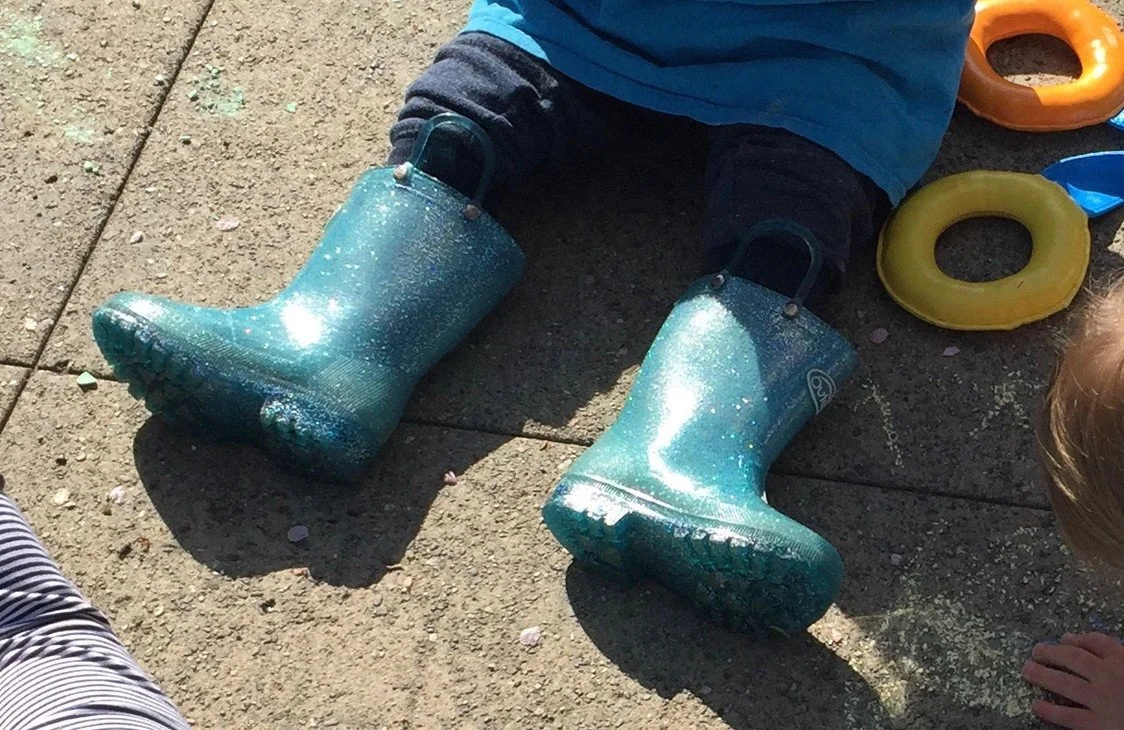Mr. Wonshu - A Lesson in Noticing and Listening
September, 2019
I was waiting with my family outside a restaurant recently when a man walked by with two young children. One looked to be about six or so and was walking next to his father. The other looked about three and his father was carrying him.
As they passed by, the young one raised his head and looked at us with a big smile.
“I’m Mr. Wonshu!” he exclaimed.
We were amused and delighted of course, but also unsure how to respond. A smile and, “all right, then Mr. Wonshu,” was about the best we could muster.
I’d like to say it was me, the early childhood professional, who noticed what happened next, but it wasn’t. I was looking through the restaurant window to see if anyone was vacating a table for four. It was my partner, Erica. (I feel I should take just a line of print here to mention that Erica is one of the most observant and attuned people I have ever known).
Looking up the block, Erica noticed a solitary tiny rain boot standing up in the middle of the sidewalk. Pivoting to see the man with the two children, who were now in the crosswalk, she saw that, indeed, the younger one was missing his boot. He only had one shoe, whose mate was retrieved and returned, and our table was at last ready.
Besides being funny, this story illustrates in a snapshot what can happen when we really notice and listen to children and their interaction with their environment. Erica let her attention and interest linger on a child’s declaration long enough to notice that he was talking about something important. Maybe it was coincidence that she then turned and noticed the one shoe. But I doubt it.
As I try to reconstruct my own response to the interaction, I realize that I had shorthanded an interpretation of what he was trying to tell us: just one of those surreal things that little children say as they reflect on the exploding data set bouncing around in their minds. I must also acknowledge that I heard, “Mr. Wonshu,” which I half assumed was a Chinese name or word he had heard– an aside to how our cultural biases and assumptions can cloud our seeing and hearing others.
The difference between Erica’s attention and mine highlight some of the basic dispositions that help educators to really see and hear children (I recommend that you investigate Deb Curtis’ Really Seeing Children for more in-depth reflections).
For a start, I think Erica recognized that this child was trying to communicate something that mattered. I laughed it off as social child trying to make a connection. But as I think about it, why wouldn’t anyone recognize his intention?
There was that mischievous twinkle, the alert raising of the head, the persuasive, assertive voice. These are all familiar cues for when children (or adults) are intent on communicating. Stanley Greenspan and Serena Wieder, writing about therapeutic intervention of children, coined the term, “gleam in the eye.” In Reggio Emilia, they call it “big ideas.”
Beyond learning to recognize children’s individual ideas, we must also foster a stance of general respect for the intellectual, creative and social competence of children. We often think of childhood as the long process of becoming a thinker, or a contributor, sometime in the future. The most respected early childhood education models challenge this assumption: children are thinkers and contributors now, and we must teach ourselves to expect them to have important things to say.
But this vignette also alerts us to something just as important as respect and recognition: the understanding that children don’t always talk to us about what we expect, and they don’t always talk to us in the way we expect.
If you were to predict how a strange child would call out to you that one of his boots had fallen off, you would probably imagine that the child would look unhappy and say something like, “my boot!” You might also expect him to tell his dad instead of a stranger.
But this child didn’t seem distressed. He seemed amused. And rather than alert the most familiar adult (the one who was carrying him), he made something of a game of it with an (admittedly very attractive and trustworthy looking) group of strangers. That’s what threw us off. Children often show the urgency of their ideas in playful ways. But the urgency and legitimacy of the ideas are always there.
Wendy Lee, a leader in developing early childhood education in New Zealand, describes their celebrated practice of writing Learning Stories in in three words: Notice-Recognize-Respond: not a script or a set or procedures, but three linked dispositions and practices.
In the United States, we have branded tips for engaging with children: talk, read, sing, for example, or strive for five. We notice some, and are quick to respond. How can we learn to go deeper into recognition?
The brief tale of Mr. Wonshu reminds us that we must cultivate an open, curious, observant nature first of all. We must enjoy noticing and listening to children. We must clear our minds of clutter and give them the attention we would give our most respected mentor.
It wouldn’t hurt for us adults to practice this with each other, too.

